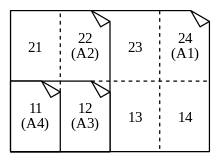In the realm of measurements, the metric and imperial systems hold sway over different parts of the world. Within the imperial system, inches reign supreme as a widely recognized unit of length. Among these inches, a4 inches hold a special place due to their significance in paper sizes and other practical applications. This article delves into the world of A4 inches, exploring their measurements, conversions, and diverse range of uses.
Understanding a4 size: Dimensions and Specifications

a4 paper Size Standard
The term A4 originates from the International Organization for Standardization (ISO) 216 paper size standard. A4 paper is defined as having a width of 210 millimeters (mm) and a length of 297 mm. When converted to inches, these dimensions translate to approximately 8.27 inches by 11.7 inches. A4 paper has become the de facto standard for business documents, letterheads, and other printed materials.
Measuring A4 Inches
Measuring A4 inches requires either a ruler or a measuring tape with imperial units. To measure the width, align the zero mark of the measuring tool with the left edge of the paper. The measurement in inches will be indicated by the point where the right edge of the paper meets the measuring tool. To measure the length, repeat the process by aligning the zero mark with the bottom edge of the paper and extending the measurement to the top edge.
A4 Size in Relation to Other Paper Sizes
A4 size is part of the A series paper sizes, which also includes A3, A5, and so on. A4 is half the size of A3, and twice the size of A5. This standardized system makes it easy to scale paper sizes up or down while maintaining the same aspect ratio. A4 dimensions are commonly used in printers, copiers, and for various printing purposes worldwide.
| Paper Size | Dimensions (inches) |
|---|---|
| A0 | 33.1 x 46.8 |
| A1 | 23.4 x 33.1 |
| A2 | 16.5 x 23.4 |
| A3 | 11.7 x 16.5 |
| A4 | 8.27 x 11.7 |
| A5 | 5.83 x 8.27 |
Converting A4 to Inches: Formula and Calculations

Converting Millimeters to Inches
To convert millimeters to inches, you can use the formula: inches = millimeters / 25.4. For A4 paper, which has a width of 210 mm and a length of 297 mm, the equivalent measurements in inches would be approximately 8.27 inches by 11.7 inches.
Decimal Inch Equivalents
In some instances, measurements may include decimal values when converting from millimeters to inches. It’s essential to understand decimal equivalents to ensure accurate conversions. For example, 1/16 inch is equivalent to 0.0625 inches, while 1/8 inch is equal to 0.125 inches.
Practical Conversion Example
If you have a document that specifies dimensions in millimeters and you need to work with inches, knowing how to convert between the two units is crucial. By applying the conversion formula mentioned earlier, you can quickly determine the corresponding measurements in inches for A4 paper.
- Width: 210 mm / 25.4 ≈ 8.27 inches
- Length: 297 mm / 25.4 ≈ 11.7 inches
Applications of A4 Paper Size

Business Documents
One of the most common applications of A4 paper is in business settings. Reports, proposals, memos, and other official documents are often prepared using a4 size paper due to its standardization and compatibility with printers and copiers.
Educational Materials
In educational institutions, A4 paper is widely used for printing worksheets, handouts, exams, and study guides. The dimensions of A4 paper provide ample space for text and graphics while maintaining a portable and easily readable format.
Creative Projects
Artists, designers, and crafters also leverage A4 paper for various creative projects. From sketching and drawing to origami and paper crafting, the versatility of A4 size paper makes it a popular choice for artistic endeavors.
Benefits of Using A4 Paper
Standardization
The adoption of A4 paper as an international standard brings consistency to document production and exchange. Users across different countries and industries can rely on A4 size specifications for seamless communication.
Compatibility
A4 size paper is compatible with a wide range of office equipment, including printers, copiers, and scanners. This compatibility streamlines document processing and ensures that printed materials fit the intended layout.
Cost-Effectiveness
Due to its popularity and widespread availability, A4 paper is cost-effective for businesses and individuals alike. Bulk purchasing options further reduce costs, making A4 paper an economical choice for everyday printing needs.
A4 Paper Size in Different Regions
Global Acceptance
While the use of A4 paper is prevalent in many countries, some regions, such as North America, predominantly utilize Letter size (8.5 x 11 inches) for printing documents. Despite this regional variation, A4 size has gained global acceptance in international correspondence and trade.
Regional Preferences
In Europe, Asia, Australia, and Africa, A4 paper is the standard choice for printing and documentation. The dimensions of A4 paper align with the ISO 216 standard, promoting interoperability and consistency in paper-based communications.
Transition Challenges
For businesses or individuals transitioning from one paper size standard to another, such as from Letter to A4 or vice versa, adjustments may be necessary in terms of formatting, layout design, and print settings. Awareness of regional preferences can help facilitate smoother transitions.
Tips for Optimizing A4 Documents
Margins and Bleed
When designing documents on A4 paper for printing, consider setting appropriate margins to ensure content is not cut off during printing. Incorporating bleed, which extends artwork or color beyond the trim edge, can prevent white borders on printed materials.
Font and Text Size
Choose legible fonts and font sizes for text-based documents to enhance readability. Optimal font sizes for body text typically range from 10 to 12 points, depending on the typeface and formatting requirements.
Orientation and Layout
Decide whether your document will be in portrait or landscape orientation based on the content and design elements. Landscape orientation may be suitable for spreadsheets, charts, or wide-format graphics, while portrait orientation is commonly used for text-heavy documents.
A4 Paper and Printer Compatibility
Printer Settings
Before printing on A4 paper, adjust your printer settings to ensure proper alignment and paper handling. Select A4 paper size in the print settings menu of your printer driver to avoid cropping or scaling issues.
Paper Tray Configuration
Verify that your printer’s paper tray is adjusted to accommodate A4 paper dimensions. Improper paper tray settings can lead to paper jams, misfeeds, and printing errors that disrupt workflow and waste paper.
Quality Considerations
Choose high-quality A4 paper for professional documents and presentations. Paper weight, brightness, and finish are essential factors to consider when selecting paper for printing, as they can impact the overall look and feel of your printed materials.
A4 vs. Other Paper Sizes
A4 vs. Letter Size
A4 paper and Letter size (8.5 x 11 inches) are the two most commonly used paper sizes globally. While A4 is slightly narrower and longer than Letter size, the difference is minimal and may not significantly affect document layout or readability.
Legal Size Comparison
Legal size paper (8.5 x 14 inches) is longer than both A4 and Letter size paper. Legal size is commonly used for legal documents, contracts, and official forms that require additional space for content.
Tabloid and Ledger Sizes
Tabloid (11 x 17 inches) and Ledger (17 x 11 inches) sizes are larger than A4 paper and are often used for newspapers, magazines, posters, and architectural drawings. These larger formats offer more surface area for detailed designs and graphics.
Future of A4 Paper Size
Sustainability Initiatives
As environmental concerns grow, there is an increasing focus on sustainable practices in paper production and usage. Companies are exploring eco-friendly alternatives to traditional paper, such as recycled paper, tree-free paper, and digital documentation solutions.
Digital Transformation
The rise of digital technology and electronic documentation is reshaping the way information is created, shared, and stored. The shift towards digital platforms, cloud storage, and online collaboration tools may influence the future demand for physical paper, including A4 size.
Innovative Applications
Advancements in printing technology, packaging design, and specialty paper products are driving innovation in the paper industry. New applications for A4 paper, such as interactive packaging, smart labels, and customized prints, showcase the versatility and adaptability of this traditional medium.
Conclusion
In conclusion, A4 inches play a vital role in the world of paper sizes and document standards. Understanding the dimensions, specifications, and practical applications of A4 paper size is essential for individuals and businesses working with printed materials. By exploring the conversions, benefits, and future trends related to A4 paper, users can optimize their document processes and stay informed about evolving industry practices. Whether in business, education, or creative pursuits, A4 inches continue to shape how we communicate and express ideas through the medium of paper.
In conclusion, A4 inches play a vital role in the world of paper sizes and document standards. Understanding the dimensions, specifications, and practical applications of A4 paper size is essential for individuals and businesses working with printed materials. By exploring the conversions, benefits, and future trends related to A4 paper, users can optimize their document processes and stay informed about evolving industry practices. Whether in business, education, or creative pursuits, A4 inches continue to shape how we communicate and express ideas through the medium of paper.